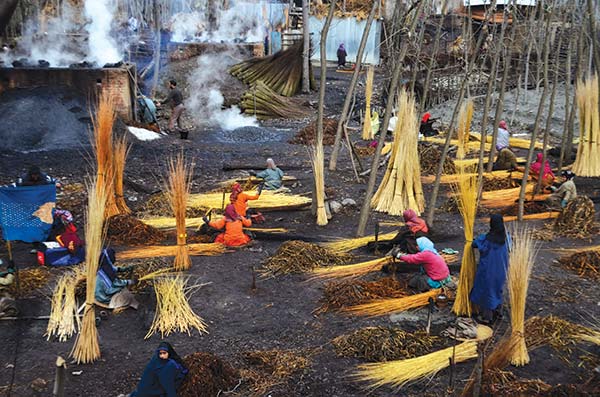by Mukhtar Ahmad Farooqi and Ghulam Hassan
The new generation is unwilling to carry forward this art as they have seen their parents living hand to mouth even after crafting so many artistic marvels.

Kashmir is famous for its handicrafts. History reveals that most of the handicrafts were brought here by the Sufi Saint Amier Kabier Mir Syed Ali Hamdani (RA) while on his Islamic preaching mission to Kashmir. The crafts that were introduced by Amier included carpet-weaving, shawl making, Numda Sazi, Paper Machie and wood carving. These crafts have provided livelihood to thousands of families and have made Kashmir famous globally.
Wickerwork is one such handicraft that is impressive, famous and requires a lot of artistry.
Willow basket making is at the core of this work. It is believed to have been brought to Kashmir by the English. Earlier it was practised in the areas of Dalgate, Habakadal, and Nawakadal. Now it exists in Ganderbal, Bandipore, Budgam and Anantnag.
In Ganderbal this craft is in vogue in Kachan, Harran, Kujar, Gadoora, Dugpora, Hakimgund, Hutbara, Sindhbal, Chundina, Shallabugh, Gogjigund, Sehpora and other adjacent villages. In these areas, this craft is the backbone of the economy.
In these areas, people earn their livelihood while being free from bonded labour.
Plant Species
Willow is a plant species (not the willow tree) and green willow is soft with inherent quality that it can be twisted into any shape. When it goes dry it becomes solid like steel. Willow plants are grown as cash crops as it requires plenty of water for its growth. Willow plant seeds are taken from the plant by cutting it into the size of (09 to 12) inches. These pieces are sown in the land called Raad one feet apart from each other from all sides in the months of February and March.

The harvesting of crop is done in the first week of November and continues up to end February. During the first crop, the plant is trimmed one inch above the ground, so that it will grow more branches in the next season. Skilled manpower is required for the harvest and most of this resource comes from Hutbara and Umerhare villages. These are being trimmed by a specially designed tool known as Aund.
Subsequently, this small plant grows into a bushy plant and yields a sufficient crop. Green willow are purchased mainly by businessmen from Umerhare and sold in Muns and (a Mun is 40 Kgs). Umerhare village is the main business unit for this raw material and graded willow.
The Processing
It is this raw material that undergoes a hectic processing. It is boiled in the Iron tanks of size of15 x6 x 6 ft feet.

First water is boiled and green willow is dipped up to top-level for 24 hours and the skin of willow is peeled. After clearance the colour of the willow changes to brown. If the green willow is cleared without boiling in the month of April after being trimmed and kept in its bottom in water, it springs and colour changes to white. After clearance, the grading is done as per length and size of willow, named as Daaie Seur, Panch Seur, Darmiean, Skien, and Sticks, the first two grades being 5 kgs. Bundles are made and for the last three 10 Kgs are made.
Generally, the cost of Green Willow in is Rs 400 to 500 per Mun.
Cost of dry and graded Willow.
i/- Daaie Seur Rs 3000/per Mun
ii/-Panch Seur Rs2500/ per Mun
iii/-Darmiean Rs1800/ per Mun
iv/ Skien Rs 2000/ per Mun v/- Sticks Rs1000/ per Mun
Willow Dalals, called Wusta Kaar purchase dry willow on large scale in wholesale rates and earn a lot of profit. These rates keep changing frequently depending on market demand. They also hire skilled labour on large scale by providing them an advance amount for marriage ceremonies, constructing houses and extract from them labour to manufacture items of their choice and earn the profit.
The artisan process begins as per the demand of items quality, size and quantity.
First Skien are divided into threes’ and fours’ by a special tool called Trishul and Chushul. After this rough surface of the divided willow is cleared by another tool known as Machine. These cleared pieces of willow in long and soft shape are known as Diel.

Willows are kept in water to make them soft before putting them into use. Artisans usually sit in groups in rooms known as Karkhanas, the manufactories. They enjoy their work a lot. Various tools are being used during the process, Knife, Aarie, Scissors, Machine, Trishul and Chushul.
These tools are manufactured at village Harran by Haji Abdul Samad Ahanger and Ghulam Mohammad Ahanger who have inherited the skill.
Promotion
Handicrafts department of Jammu and Kashmir is organizing exhibitions on large scale to sell the manufactured items and give profit to artisans. The manufactured willow items are sold and reach almost all corners of India and abroad as well. It gives a sufficient amount of foreign exchange to the country.
Despite these initiatives, the new generation is unwilling to carry forward this art as they have seen their parents living hand to mouth even after crafting so many artistic marvels. If Kashmir does not want to lose this indigenous art, it may have to introduce some genuine, sincere and alluring initiatives need to be taken by the government to motivate the younger generation to learn and carry forward this art of willow work else it is going to die a silent death.
(Ghulam Hassan Wani, a teacher belongs to the area and offered the details that were used in this write-up.)















